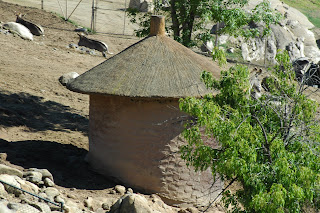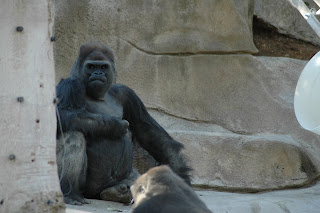
On the 6th of February, we drove north to Stevenson’s Ranch, which is near Santa Clarita, where my nephew Buddy and his wife Rose live in a beautiful home, perched high on a hill that overlooks the hustle and bustle of the city streets below.
Bud owns a company called Fountain Supply, which fabricates and supplies parts for fountains all over the world. His is a family business, where his wife and all three of his sons work. Tom, the oldest, is an engineer like his Dad, and does the design work for special applications. Michael is the salesman of the family, and Jonathan, the computer aficionado, is in charge of pricing updates and working on their web site redesign.

My sister Jane arrived the next day for a weeks visit. We picked her up at the Bob Hope Airport in Burbank. This is a great little airport that still boasts only two arrival and departure gates. Easy in, easy out.
On Thursday, while the family business ran on their normal schedule, Jane, Marlin and I visited Forest Lawn Memorial Park & Mortuaries, which encompasses 300 landscaped acres and a collection of replicas of the world’s greatest masterpieces.
The creator of Forrest Lawn strove to create a burial site that would be enjoyed for it’s beauty and inspirational art. There is a stained glass window that is a copy of Leonardo da Vinci’s Last Supper, created from the artists original drawings by an Italian woman known for her old world technique in the making of stained glass windows.
Other highlights include an entire building wall that is made with thousands of 1 or 2 inch squares pieced into a mosaic that depicts great moments in American history, a different building has a mosaic wall covered with scenes from the life of Lincoln. There are authentic copies of many of Michelangelo’s world famous statues that can be viewed in the mausoleum.




Over the weekend we all went to the Reagan Library. The buildings, as well as Reagan’s burial site, sit at the end of a steep, winding road, high on the edge of a hill that overlooks Simi Valley and the Pacific Ocean. Classic memorabilia, including a large section chronicling his years in Hollywood, are displayed along wide corridors designed for moving crowds along smoothly.
There were some fun old movie clips we watched that made me think he was not a bad actor at all. The museum included as much information about Nancy as it did about Ronnie, but it was laid out well and gave you a clearer look at how he had evolved from a sports reporter, through spokesman for the Actors Guild, to Governor and then President.
A separate pavilion, adjacent to the museum, was built in 2004 to house Air Force One. After being decommissioned in San Bernardino, the plane was disassembled and transported by truck the 104 miles north to the Reagan Library. Only a roof and 2 ½ walls of the Pavilion had been erected before the plane was towed inside and reconstructed. The remaining walls were built around the aircraft. The new facility opened in October of 2005.
During its years of service, 1972 through 2001, it was “Air Force One” for seven presidents-Nixon, Ford, Carter, Reagan, H.W. Bush, Clinton, and W. Bush. It was interesting to learn that it was only called “Air Force One” when the current President was on board. When other government officials, such a Colin Powell, used the plane it was just U.S. “27000”. It is worth a trip here just to see the Boeing 707 that flew so many Presidents around the world.





Ronnie's view


An original piece of the Berlin wall

Air Force One
Sunday was a day for visiting and reminiscing. We spent the morning with Buddy’s son Tom and his new daughter. Jane’s great grand daughter, Clair, is eleven months old and not too sure about all these new people invading her territory, but as long as Mom and Dad were close by, she was happy enough We took her to the William S. Hart Ranch where they have a small collection of animals. She likes the geese best of all. Probably because they are so noisy when you walk up to their fence.

Tom and Clair


Rose with her ganddaughter

One proud grandpa
After Clair left for her nap, we toured the house that William S. Hart had donated to the city of Newhall. Hart was a western movie star in the early 1900 and wanted his land and home to be enjoyed by the public after his death, so he donated the house and 265 acres as a public museum.
The grounds include an elaborate grave site of his favorite pinto horse “Fritz, a dog cemetery where 10 or 12 dogs, each with their own cement headstone were buried, a small herd of Bison, and La Loma de los Vientos (The Hill of the Winds) ranch house.
Hart, his sister Mary Ellen, and the live-in housekeepers, were the only people to ever occupy this home, therefore all the furnishings, dishes and art work are original to Hart. The most outstanding feature is his collection of western art. He was very close friends with Charles Russell, Frederick Remington, and Joe De Young, all widely famous artist of that era. Still hanging on the walls are numerous paintings from all these men as well as other western artists that I was not familiar with, and many authentic Indian artifacts. The collection must be worth millions today.
From there, our journey turned nostalgic. Since it was lunch time we scouted out an old High School hang out of Marlin’s called Cupid’s Hot Dog Stand where they only serve hot dogs in natural casings, smothered in mustard onion and chili. Marlin swears they are just as good as they were 50 years ago. We all agreed they were pretty tasty.

Hart Ranch house



The pool was filled in after the 1976 earthquake


Yum
Next stop was a trip past the house and dead end street where Jane moved when she first came to California in 1963 and where Buddy and his sister Paula grew up. It is still a horsy neighborhood as it was then because it is adjacent to a large natural wash area. Since water only flows here about once a year, the rest of the time it is used by equestrians and coyotes. The neighborhood, houses and yards seemed much smaller than I remembered.
Marlin and I had rented a tiny house about five miles up in the hills shortly after we got married, in fact we celebrated our first anniversary there. Since we were so close, we gave that place a drive by also. We still remembered the address, but it took a few tries before we located the road. An odd little neighborhood, nestled in the mountains. We decided we could still live there if this four room house didn’t cost $400,000!

12319 El Mary Del Drive, Kegal Canyon, CA
In downtown Los Angeles, at the site of the 1781 settlement that became El Pueblo de la Reina de Los Angeles (The town of the Queen of Angels), there remains the oldest existing house in the city. The Avila Adobe, on Olvera Street, was built in 1818, by Don Francisco Avila. His family was a typical ranching family of the time, trading in cowhides and tallow. Eventually Avila became mayor of Los Angeles in 1810.
The years between 1868, when the last of his family left the area, and 1926, the year the city condemned the adobe, saw a steady decline in the house and the neighborhood. In 1928 a local woman, Christine Sterling, galvanized support from influential friends and restored the Avila Adobe and created a Mexican style market place on Olvera Street, which since then has became a popular tourist attraction.
Today the house appears much as it did in 1840 and is open to the public free of charge. The open air Mexican market surrounds the building and offers colorful Mexican clothing, well made, bargain priced, leather goods and more souvenirs that you can possibly look at in one day. We spent the better part of the morning wandering through the shops enjoying the exposure to California’s Mexican culture.






Across from Olvera Street is Union Station, built in 1939. This magnificent building blends the Spanish Mission style with Art Deco to create a structure more like a church than a train station.
After entering the front doors you see broad graceful arches, dark wood beamed ceilings that are 50 feet high, and a marble floor laid in multi colored triangles. Adjacent courtyards are filled with tiled fountains and abundant plantings. Lots of people having their lunch here.
The station was originally designed to be the transportation center for all of California, however, after the Second World War, train travel gave way to auto and air travel and the station went into decline. In 1990 it was revitalized as the city’s hub for bus, Amtrak trains and subway transportation. Quite a showplace today. The old ticketing area is now available for function rentals or, as a sign on the wall advertised, film productions. Guess this space is not necessary any more, since bus and train tickets are now purchased from machines attached to the walls.

Buddy pointing out some of the fountain fixtures sold by his company.









The diningroom of the resturaunt called "Trax" within the station



























